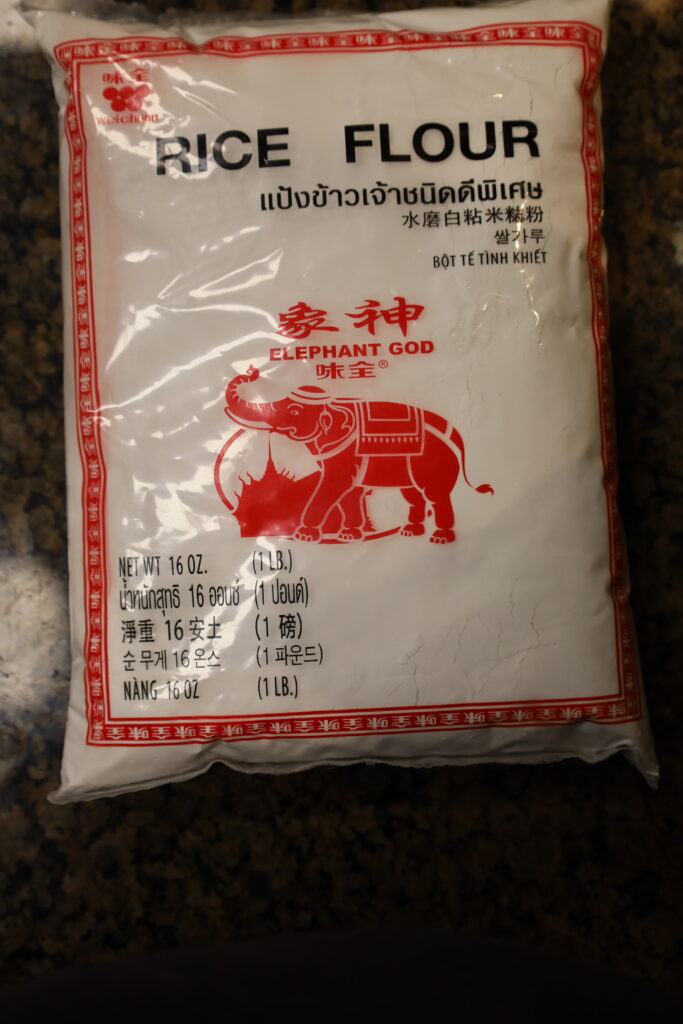
The use of rice flour in the US is unfamiliar. It is becoming, and has become, more common in those groups who adhere to a gluten free diet however. When I originally started using rice flour for some of the wrapped recipes you will see in this website and in the book series, I didn’t realize that a straight conversion from wheat flour would result in failure. I don’t mean a straight conversion just in measurement, but also in handling and preparing.
Rice flour is distinct from rice starch. Rice starch can be substituted for corn starch, however it is not as strong a thickener. Corn Starch, potato starch, tapioca starch, arrowroot wheat starch and rice starch can all be used as thickeners (starch is also made from sweet potato, mungbean and sapgo and sometimes used in Asian cuisine). Rice starch is made by steeping the rice in lye.
Rice flour however, is made by grinding the raw rice kernels into flour, just like wheat flour is made. Most rice is made from the Indica, japonica and wild varieties of rice.
There are 3 categories of rice flour, white, brown and sweet.
- White rice flour: This is the most common type of rice flour found in Asian markets and now more commonly in US markets. White rice has the bran removed before it is ground.
- Brown rice flour is not common in the US. Red Mill makes a brown rice flour, and you can see this occasionally in Asian groceries. The outer hull of the rice is removed but the germ maintained in the processing, the grain is then ground into flour. As with whole wheat flour baked goods using brown rice flour tend to be heavier and coarser. They are more “nutty” and “earthy” in flavor, which many find to their liking.
- Sweet Rice, glutinous rice, mochiko (in Japanese) or sticky rice is milled from a short grain “glutinous” rice. The glutinous quality just means sticky. I have never understood why this is called “sweet” rice, as it doesn’t taste at all sweet to me. However, if you are looking for this on store shelves, sweet rice is a commonly used English name for this rice.
Substituting rice flour for wheat flour can be very difficult. A 1:1 conversion will not work and will yield a failed product in many dishes. Further rice flour contains no gluten, which is a positive if one is looking for a gluten free product, however, will not work for yeasted breads (unless one mixes this with wheat flour).
Rice flour will absorb a tremendous amount of liquid, a fact I didn’t understand when I first worked with this ingredient. Obviously, in our website and book, the recipes were designed for rice flour. However, some pearls of the use of rice flour were missing. So much that is on the web about the using of rice flour is focused on gluten free baking. However, rice flour can be used as a thickener, a coating for deep frying or baking, or can be made into a dough or batter. A few pearls that may help you as you try some of the recipes on our website:
- When you add water to rice flour you get a mushy, sticky mess. Spray your hands with Pam or other cooking liquid if you are forming dumpling skins, mixing dough or batter and using your hands.
- Use hot water when making a dough or batter.
- Do not substitute rice flour for recipes designed for wheat flour. Use recipes that are designed for rice flour or those that are designed to use a combination of flours in baking.
- Let the flour sit in the hot water for a good 15-20 minutes, before continuing with the recipe.
- Some recipes just don’t seem to take into consideration the fluid to flour needs. So be aware that sometimes you will end up with a solidified lump of dough straight from the recipe. Obviously additional fluid must be added.
- Keep vigilant when you are first using this flour, watch, touch, and learn what works best in your kitchen and for you.
- Enjoy the experience of using rice flour to make wrapped dishes.







